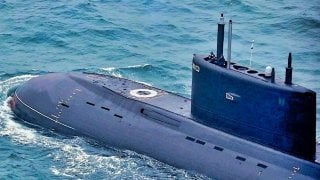'The Entire Crew Might Have Suffocated': How China Lost An Attack Submarine
In 2003, Chinese submarine 361, a Type 035G vessel, experienced a fatal mechanical failure during a training exercise, resulting in the deaths of all 70 crew members.
What You Need to Know: In 2003, Chinese submarine 361, a Type 035G vessel, experienced a fatal mechanical failure during a training exercise, resulting in the deaths of all 70 crew members.
-The submarine, part of an aging fleet, was later recovered from Chinese waters, but details about the incident remain scarce.
-Experts speculate that a malfunctioning diesel generator may have depleted the oxygen supply, leading to suffocation. Alternatively, a carbon monoxide leak could have been responsible.
-Despite being one of China’s deadliest peacetime naval disasters, the exact cause remains unclear due to Beijing’s lack of transparency.
The Mystery of Submarine 361: China's Deadly 2003 Naval Disaster
In 2003, a Chinese Type 035 submarine, identified as submarine 361, suffered a mechanical failure during a training exercise, resulting in the deaths of all 70 crew members. The submarine, part of an aging fleet considered obsolete by the early 2000s, was later recovered from Chinese waters.
Beijing offered limited details, but experts speculate that the disaster was likely caused by a malfunctioning diesel generator, leading to suffocation due to oxygen depletion or a poisonous gas leak.
The exact cause remains unclear due to the Chinese government's lack of transparency regarding the incident.
In 2003, a Chinese Type 035 submarine suffered a mechanical failure that would lead to one of the country’s most severe peacetime military disasters. All 70 crew members on board the submarine were killed during a training exercise.
The vessel, identified as submarine 361, was recovered from Chinese territorial waters east of the Neichangshan Islands days later.
Introducing Submarine 361
Submarine 361 was developed as a Type 035G vessel, a sub-type produced between 1990 and 1999. Twelve Type 035G boats were designed to incorporate an array of capabilities including noise reduction and stronger weapons.
These aging vessels were considered obsolete by the early 2000s, and Chinese officials, according to some reports, referred to the upgraded variants as “new wine in an old bottle.”
The Accident
Right after the accident, a Chinese Foreign Ministry spokesperson said that the submarine was “training in our territorial waters east of the Changshan Mountains, all 70 officers and soldiers on board were killed due to mechanical failure,” and provided no further details.
The spokesperson only said that, “submarine 361 was a major loss for the People’s Navy. We express our deep condolences to all officers and soldiers of the submarine who were unfortunately killed in the execution of training tasks, and sincere condolences to the relatives of the killed officers and soldiers.”
What Really Happened? Suffocation Is Possible
Beijing is not known for its transparency, so a more detailed analysis of the submarine 361 mishap was never to be expected. However, one leading theory surrounding the event is that the submarine’s onboard diesel generator could have malfunctioned and used up all remaining oxygen.
If this is true, the submarine crew likely suffocated at their posts before even recognizing any danger.
Other experts have speculated that a poisonous gas, perhaps carbon monoxide, could have leaked from the ship’s diesel engines, also resulting in suffocation.
Without a thorough and transparent review of the tragic submarine 361 incident, we may never know why the vessel’s 70 crew members died.
About the Author: Maya Carlin, Defense Expert
Maya Carlin, National Security Writer with The National Interest, is an analyst with the Center for Security Policy and a former Anna Sobol Levy Fellow at IDC Herzliya in Israel. She has by-lines in many publications, including The National Interest, Jerusalem Post, and Times of Israel. You can follow her on Twitter: @MayaCarlin.
Image Credit: Creative Commons.


